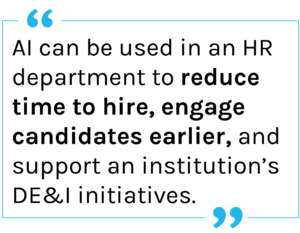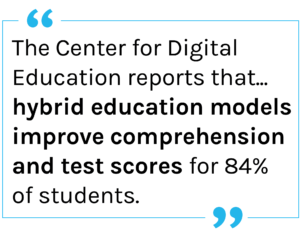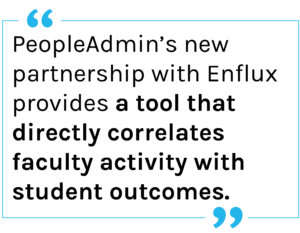Learn how to minimize admin and free up your time to focus on student success.

Higher education institutions have a common purpose: to educate students and shepherd them through graduation. While institutional missions may vary, including a focus on creating leaders or citizens of the world, or on research or liberal arts education, the core mission of student success remains the same.
At any college or university, each department has its own goals and metrics, but at the heart of their work is the institutional mission. Whether you are a member of an HR, IT, or finance team, an administrator, a faculty member, or staff member, your role connects—directly or indirectly—to student success. Still, unless you have the right tools, it’s easy to get lost in administrative work and lose the connection to educating students. Here are five tools that can help you and your institution save time on administrative work and shift your focus to student outcomes!
1. Artificial Intelligence and Automation
Artificial intelligence is a powerful tool for higher education institutions to leverage, and can have applications in many different areas, all designed to save time on administrative work and offer personalized experiences to users—whether they are candidates, staff, faculty, or students.
 AI can be used in a human resources department to reduce time to hire, engage candidates earlier, and even support your institution’s DE&I initiatives, all while saving your HR team time and money. Conversational AI tools like Olivia from Paradox can help automate some of your recruiting tasks. With a reduced administrative burden, your team is freed up to spend more time on people and on strategy, ensuring the best candidates are hired and retained—and those hires can positively impact student outcomes.
AI can be used in a human resources department to reduce time to hire, engage candidates earlier, and even support your institution’s DE&I initiatives, all while saving your HR team time and money. Conversational AI tools like Olivia from Paradox can help automate some of your recruiting tasks. With a reduced administrative burden, your team is freed up to spend more time on people and on strategy, ensuring the best candidates are hired and retained—and those hires can positively impact student outcomes.
Automation can be benefits teams across your campus, including by student services teams to offer more personalized support to students. For instance, Arizona State University set up timed emails to remind students to apply for financial aid, increasing the number of FAFSA applications submitted before the deadline. Lack of financial resources are a major driver of dropout rates, and ASU’s strategy increased its student’s chances of receiving federal financial support.
2. Data Analytics
Data is already ubiquitous on your campus. The only question is, are you getting all the insights you can out of that data? There are so many ways that analytics can help an institution achieve its mission. A report by the Deloitte Center for Higher Education Excellence considers Bucknell University, which “has been using predictive modelling to … arrive at a “success score.” Bucknell then uses this success score to personalize student support and university intervention. The type of pre- and post-enrollment data used for such predictive modeling is likely already available at your institution—although, if you don’t have a robust, connected tech system, your data could be hidden in spreadsheets and filing cabinets, making it harder to leverage. Connecting your campus with technology allows you to monitor the student lifecycle, understand patterns of student engagement, and adjust to student needs in real-time. Read more about using data to achieve your institution’s mission.
3. Digital Classroom Tools
Since COVID-19 initiated the emergency move to remote learning, teaching, and working, most higher education institutions are familiar with the tools that support a digital-age classroom. According to Deloitte, “the Center for Digital Education reports that blended or hybrid education models improve comprehension and test scores for 84 percent of students.”
with the tools that support a digital-age classroom. According to Deloitte, “the Center for Digital Education reports that blended or hybrid education models improve comprehension and test scores for 84 percent of students.”
Virtual reality offers incredible opportunities to students, including hands-on virtual lab experiences and virtual field trips. Techniques like the flipped classroom, along with technologies like video conferencing, interactive and collaborative learning software, learning management systems, and even robots can positively impact student outcomes by increasing access to learning opportunities and materials and encouraging collaboration.
Remote and hybrid classroom experiences also offer more opportunities for adaptive learning programs. Adaptive learning, according to EdTech Magazine, “uses data and aspects of artificial intelligence to tailor material to the specific student, [and] is a way for colleges to turn away from dispensing one-size-fits-all curriculum.” When your institution takes advantage of all the ways a classroom can utilize technology, faculty are better able to tailor a learning experience to any student’s individual pace or needs, meaning students won’t fall behind.
4. Faculty Digitization
Faculty are often seen as the members of your institution with the most impact on student outcomes, but, according to a 2020 PeopleAdmin survey, 48% of institutions still use predominantly paper processes for faculty. If you aren’t yet utilizing technology to support your faculty, they are struggling under unnecessary administrative burden. Applying for grant funding , tracking work history and achievements, personalizing dossiers, and pulling together information for promotion and tenure review processes can take up a great deal of faculty time—time that would be better spent focusing on student success, teaching, and mentorship.
Tools like PeopleAdmin’s Faculty Information System can centralize and digitize faculty data and information, streamlining repetitive processes and increasing data accuracy while giving time back to your faculty. When your institution has better access to the information it needs—like faculty teaching and research workload, grants, and publications—leaders can make data-driven decisions that will impact student outcomes.
The right faculty information system can also take your data connections to the next level. PeopleAdmin’s new partnership with Enflux provides a tool that directly correlates faculty activity with student outcomes, offering a comprehensive data-backed solution that provides actionable insights to optimize curriculum, support faculty in their jobs, and increase student success. Read more about this game-changing partnership.
with Enflux provides a tool that directly correlates faculty activity with student outcomes, offering a comprehensive data-backed solution that provides actionable insights to optimize curriculum, support faculty in their jobs, and increase student success. Read more about this game-changing partnership.
5. Mobile Technology
Students today rely on and thrive on mobile technology and flexibility. Many students use mobile devices to complete coursework, so it’s important that whatever learning platforms and technologies your institution is using are mobile-friendly. Students want a seamless digital experience in every aspect of their lives; the more your institution can offer to students on mobile tech—from course enrollment to assignment tracking to viewing campus event schedules—the more you will be able to engage your students and positively impact retention.
Deloitte’s report on student success noted that “when institutions deliver services such as advising, counseling, and financial aid only through face-to-face meetings during normal business hours, students who have jobs, families, and other off-campus responsibilities are less apt to take advantage of them.” Especially at a time when student mental health is a growing concern for colleges and universities, access to services like mentorship and counseling via mobile or digital means can increase access for those who need support. Studies suggest that improving student mental health can be linked to higher graduation rates and greater student success – so accessible, digital student services can have a significant impact on your institution’s core mission.

Final Thoughts
Higher education is undergoing a period of massive digital transformation, and there are countless technologies available for you, your team, and your institution to take your digitization to the next level. After the challenges of 2020 and 2021, it’s time to minimize the distraction of admin and re-focus every corner of your campus on your institutional mission and on student success.